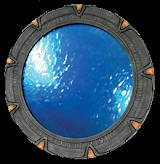If so, put them in a sack. That's it, just shame them by putting them in a sack...
Physics A and B discussed their lab work on pulleys from Friday before taking on circular motion in more depth. We looked at the two velocities involved in circular motion (angular and tangential) and then looked at the acceleration that reported the rate of change of these velocities (angular and tangential). Those accelerations only reflect the speed portion of those velocities, however. The direction portion of the velocities is measured by centripetal acceleration. And, since accelerations are produced by forces, we took time to look at centripetal force and will hit torque a bit later on. Centripetal force and acceleration point towards the center of a circle (regardless of orientation of the circle) and the role of centripetal force can be assumed by any force (gravity, friction, normal force, etc.). We'll go over our homework problems for centripetal force and acceleration tomorrow before looking at one force that can act as centripetal force - gravity.
Intro Physics took time to do some peer editing of their buoyancy questions before diving into a couple of challenge problems involving buoyant forces. We'll look over those on Wednesday, as well as go over tomorrow's lab dealing with buoyant forces.
Honors Physics also worked with buoyant forces today. We defined the terms 'fluid' and 'density,' then turned attention to how Archimedes used information from observations on displacement and apparent weight to form what we today call Archimedes Principle. We looked at some helpful formulas for dealing with buoyant force and related the interplay of an object's weight and the buoyant force provided by a fluid to the concept of floating and sinking. We'll go over the homework problems tomorrow before starting to take a look at fluid pressure.
skip to main |
skip to sidebar

Code Talker by Chester Nez



Ready Player One by Ernest Cline

Invasion of the Body Snatchers
Swiffer
Cyber.Vision
- Hitchhikers Guide to the Galaxy
- Battlestar Gallactica
- Quantum Leap
- Star Trek
- Stargate Atlantis
- Firefly
- Eureka
- Heroes
- MacGyver
- Highlander
- Fringe
- Lost in Space
- Cosmos
- The Twilight Zone
- The Time Tunnel
- Land of the Giants
- Voyage to the Bottom of the Sea
- ALF
- Total Recall 2070
- Pokemon
- Night Gallery
- The Invisible Man
- The Dresden Files
- The Outer Limits
- Buffy the Vampire Slayer
- The Incredible Hulk
- NOVA
- SciFi Wire
Book.Read

Code Talker by Chester Nez
Links.Zone
- Introductory Physics MCAS Review
- The Physics Classroom
- Khan Academy
- NASA
- Technology Review
- DVICE
- LOCUS Online
- Hugo Awards
- Nebula Awards
- Saturn Awards
- SF Signal
- SciFi Lists
- New England Science Fiction Association
- Evil Mad Scientist Laboratories
- SciFi Channel
- Star Trek
- Star Wars
- Stargate
- Web Sudoku
- SET Daily Puzzle
- Quiddler Daily Puzzle
Advice

Pod.Casts
The.Archive
NASA.Img
Engadget
APS.Org
Gizmodo
Physics.Today
Physics.World
Get.Wired

Quality.Read

Ready Player One by Ernest Cline
Screen.Time

Invasion of the Body Snatchers
TechCrunch
CNET.Buzz
PCM.News
NewSci.Tech
SciAm.Physics
NASA.News
NewSci.Space
And.Furthermore
no matter where you go...there you are...

